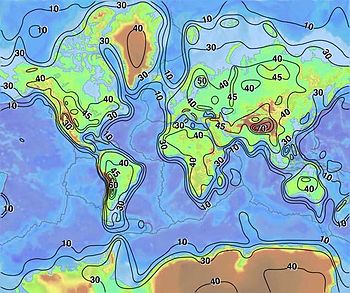
Continental crust
Did you know...
SOS Children volunteers helped choose articles and made other curriculum material SOS Children works in 45 African countries; can you help a child in Africa?
The continental crust is the layer of granitic, sedimentary, and metamorphic rocks which form the continents and the areas of shallow seabed close to their shores, known as continental shelves. This layer is sometimes called sial due to its granitic rock, in contrast to the oceanic crust, called sima due to its basaltic (also called mafic) rock. Due to the change in velocity of seismic waves it is believed that on continents at a certain depth sial becomes close in its physical properties to sima and the dividing line is called Conrad discontinuity. Consisting mostly of granitic rock, it has a density of about 2.7g/cm3 and is less dense than the material of the Earth's mantle, which consists of mafic rock. Continental crust is also less dense than oceanic crust, though it is considerably thicker; mostly 35 to 40 km versus the average oceanic thickness of around 7-10 km. About 40% of the Earth's surface is now underlain by continental crust.
Because continental crust mostly lies above sealevel, its existence allowed land life to evolve from marine life. Its existence also provide broad expanses of shallow water known as epeiric seas and continental shelves where complex metazoan life could become established during early Paleozoic time. If Earth was like the other silicate planets and lacked the duality of oceanic and continental crust, our planet would be a very different place and the evolution of Homo sapiens and civilization would have been impossible.
In contrast to the relative permanence of continental crust, the size, shape, and number of continents is constantly changing, as different tracts rift apart, collide and recoalesce as part of a grand supercontinent cycle. Today there are ~7 billion cubic kilometers of continental crust, but in the past there may have been fewer or more. The relative permanence of continental crust contrasts with the short life of oceanic crust. As a consequence of the density difference, when active margins of continental crust meet oceanic crust in subduction zones, the oceanic crust is typically subducted back into the mantle. Because of its relative low density, continental crust is only rarely subducted or re-cycled back into the mantle (for instance, where continental crustal blocks collide and overthicken, causing deep melting). For this reason the oldest rocks on Earth are within the cratons or cores of the continents, rather than in repeatedly recycled oceanic crust; the oldest continental rock is the Acasta Gneiss at 4.01 Ga, while the oldest oceanic crust is no older than Jurassic (~180 Ma). Continental crust and the rock layers that lie on and within it are thus the best archive of Earth history.
The height of mountain ranges is usually related to the thickness of crust. This results from the isostasy associated with orogeny (mountain formation). The crust is thickened by the compressive forces related to subduction or continental collision. The buoyancy of the crust forces it upwards, the forces of the collisional stress balanced by gravity and erosion. This forms a keel or mountain root beneath the mountain range, which is where the thickest crust is found. The thinnest continental crust is found in rift zones, where the crust is thinned by detachment faulting and eventually severed, replaced by oceanic crust. The edges of continental fragments formed this way (both sides of the Atlantic Ocean, for example) are termed passive margins.
The high temperatures and pressures at depth, often combined with a long history of complex distortion, mean that much of the lower continental crust is metamorphic - the main exception to this being recent igneous intrusions. Igneous rock may also be "underplated" to the underside of the crust, i.e. adding to the crust by forming a layer immediately beneath it.
Today there are ~7 billion cubic kilometers of continental crust, but in the past there may have been less or more. Today continental crust is produced and destroyed mostly by plate tectonic processes, especially at convergent plate boundaries. New material can be added to the continents by the partial melting of oceanic crust at subduction zones, causing the lighter material to rise as magma, forming volcanoes. Also, material can be accreted "horizontally" when volcanic island arcs, seamounts or similar structures collide with the side of the continent as a result of plate tectonic movements. Continental crust is also lost, due to erosion and sediment subduction, tectonic erosion of forearcs, delamination, and deep subduction of continental crust in collision zones. Many aspects of crustal growth are controversial, including rates of crustal growth and recycling, whether the lower crust is recycled differently than the upper crust and over how much of Earth history plate tectonics has operated and so could be the dominant mode of continental crust formation and destruction. It is a matter of debate whether the amount of continental crust has been increasing, decreasing, or remaining constant over geological time. One model indicates that at prior to 3.7 Ga ago continental crust constituted less than 10% of the present amount. By 3.0 Ga ago the amount was about 25% and following a period of rapid crustal evolution it was about 60% of the current amount by 2.6 Ga ago (Taylor and McLennan, 1995). The growth of continental crust appears to have occurred in spurts of increased activity corresponding to five episodes of increased production through geologic time (see graphic at Butler).


